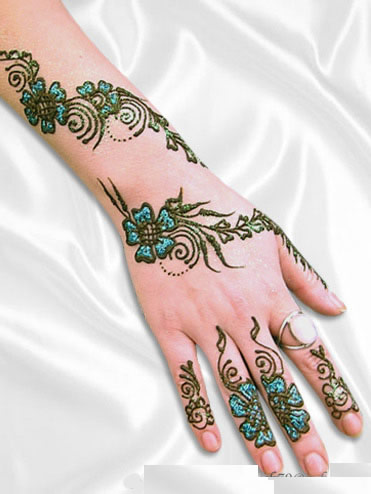Mehndi Designs Images Biography
source{google.com.pk}Testimony or other evidence are numerous: there are 5000 years of Egyptian henna stained nails and hair of the mummies, we found traces that of Ramses II the legend of Baal and Anath, written in Syria around 2100 BC JC. reveals the female use of henna on the hands, in the nuptial rites; hands statuettes Minoan or Mycenaean female deities (to 1 700/900 BC. JC). wear marks typical henna patterns the Carthaginians brought the practice of drawing henna body up to North Africa and the Iberian Peninsula … Romans, Jews, Christians and Muslims from Arabia and elsewhere more or less commonly practiced this art.
The introduction in India seems to date back to the fifth s., As might prove discoveries in the caves of Ajanta. In these times, men and women, rich and poor, humans, gods and demons were represented with henna body decorations.But it is, in XII century., The arrival of the Mughals, Muslims, which marks the beginning of a tradition and a culture of mehndi in the Sub-Continent. Rajput rulers of Udaipur (Mewar or at Rajasthan) used the henna application on hands and feet, to name a famous reference. Preparations, application techniques, patterns, then became increasingly sophisticated, and usage patterns increasingly embedded in everyone’s life, according to aesthetic principles, religious, cultural or medicinal. It should be noted that a very typical and traditional occasion the mehndi is use all wedding ceremonies: here you can reach the most ancient practices, mentioned above.
The reasons for Indian mehndi are varied and interlacing geometric figures among Muslims, motifs, often inspired by nature (birds, mango leaves and flowers …) among Hindus, while Tamils resorted to circular designs in the palm and flat colors wrapping fingers and around the feet.If one wants to practice henna temporary tattoo, you can either buy ready made kits or make a more traditional way, preparing the dough needed and by making the cone used for the application.
Mehndi or Henna is commonly found herb which is used for embellishing and decorative purpose. It is a common tradition in sub-continent (India and Pakistan).HISTORY AND ORIGIN: Mehndi goes back into long time back in history. At first it was used by only ethnic and symbolic groups for identification purposes. Gradually it developed as symbol of rejoice, glee and happiness. Its usage for decorating body goes back into old Egyptian times. Islamic culture also included it. It has been used by women for centuries on hands, nails, soles and hair to beautify themselves.IN MODERN WORLD: In modern world, it is still used in celebrations and it depicts happiness. Brides specially use it and the darker the hue of their henna, the luckier they consider themselves. Eid, Diwali, Wedding, it is used by women all ova world specially indo-pak to show how happy they are.ORNAMENTAL PURPOSE: Mehndi has helped adorn and beautify women all around the world. It’s cheap yet beautiful. It has a fascinated human generations by its aroma throughout the centuriesMEHNDI DESIGNS AS AN ART: Henna practice has achieved the level of an art these days. There are different kinds, different consistencies, timings and color saturation levels attributed to mehndi nowadays.
Have you ever gone to an Indian or Pakistani wedding ceremony and been stunned by the beauty of the designs and artworks on the hands and the feet of the bride? May be, you’ve ever seen that before but you don’t have any idea what it was,that artworks are called mehndi, and they are painted using henna (usually natual one). The origin of Henna is from the leaves of the henna plant with the scientific name of cypress flower plant, and the word henna itself comes from the Arabic word of hinna. There are three different types of mehndi available, they are instance Indian mehndi, Pakistani mehndi and Arabic mehndi. It is believed that the art of painting henna on the body parts has been done for more than 5000 years, but there is not enough fact to support this theory. Some historians believe that the Mughals brought this art to India, but some others believe that the origin of this art is actually from India. Some others also state that mehndi was first found in Middle East, and even North Africa. There are so many different opinions and theories from the experts on the history of this art. Nevertheless, some archaeologists found a fact that black henna was actually used in Egypt during the times of the pharaohs. They have found some mummies with black henna on their toes and fingers. Mehndi henna designs are always used in Indians wedding, and the folk stories have mentioned them since a long time ago. The usage of wedding mehndi are still done until today, and in some countries such as Yemen, the art of applying mehndi for a wedding would be done for four or five days as traditional requirements during the wedding festival. It’s not really different in Pakistan, the brides usually decorate themselves with gorgeous mehndi to make an extra-ordinary look on their big day. Nowdays, there are so many mehndi henna design books published, they explain the numerous mehndi stages to take to complete the art of mehndi,a clear indication showed that mehndi have changed and developed from time to time. Nevertheless, the historical art of mehndi keeps atracting millions of people around the world, and would continue to do so for years ahead!.
Mehndi Designs Images Henna Hands Pictures Images Pics

Mehndi Designs Images Henna Hands Pictures Images Pics

Mehndi Designs Images Henna Hands Pictures Images Pics

Mehndi Designs Images Henna Hands Pictures Images Pics

Mehndi Designs Images Henna Hands Pictures Images Pics

Mehndi Designs Images Henna Hands Pictures Images Pics

Mehndi Designs Images Henna Hands Pictures Images Pics

Mehndi Designs Images Henna Hands Pictures Images Pics

Mehndi Designs Images Henna Hands Pictures Images Pics

Mehndi Designs Images Henna Hands Pictures Images Pics

Mehndi Designs Images Henna Hands Pictures Images Pics
No comments:
Post a Comment